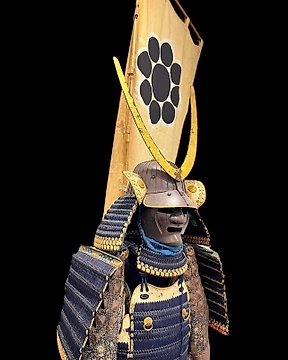
Eine sehr beeindruckende japanische Samurai-Kriegsrüstung Mogami Dou Gusoku aus dem Hosokawa-Clan um - Stoff, Eisen, Leder. - Mito ju Yoshinobu - Japan - um 1700
Nr. 83969353

Nr. 83969353

Ryoha Omi Yari with full set Koshirae & Shirasaya, with NBTHk Hozon paper with Sayagaki signed as:(匚米)陽国(以下不明) Hanyou-Kuni (below unknown) attributed to:(匚米)陽国播陽国衛壮金重 Hanyou-Kuni Eiso Kaneshige This smith uses a very rarely used location name with a very rarely used Kanji character. The single Kanji character combines by “匚米”, is deemed to be a variation of 播, and the name 播陽国 is deemed to be another name of the more commonly known 播磨国, the country of Harima, today’s southern Hyogo prefecture. Thus, this smith is also known as 播陽国衛壮金重. There’s very very limited info I can find regarding him. Based on date inscription from other pieces by him, it seems like he is mainly actived during early to mid Edo period. All of his works I’ve seen are polearm blades, including Jumonji-Yari, Kata-kama-Yari, and Omi-Yari like this piece. It’s no doubt that he focus on polearm making and has excellent skill in this field as all the pieces I’ve seen from his are excellently made. Some Japanese dealers claim he has a 業物Wazamono ranking, but I can’t find other records regarding this, thus can’t be sure. 大身槍Omi-Yari, transalted as “large body spear”, refers to those Yari with over 2 Shaku in Nagasa (or 1 Shaku depending on different theories). This particular piece has a whopping 2 Shaku 4 Sun 5 Bu Kyo (74.24cm or 29.23in) in blade length, longer than most of Katana blades from the same time period. Note that this measurement is given in the Hozon paper, and a different measurement (2 Shaku 2 Sun 7 Bu) is given in the Sayagaki. This difference is probably caused by different way of defining the “Nagasa”, one includeds the length of 螻蛄首Kerakubi (the “ricasso” part), one doesn’t As shown in the photos, this particular blade is in 両刃Ryoha (double edged) style. It’s slightly more common to see on Omi-Yari than Sankaku triagular style because Omi-Yari were meant to be a weapon heavily emphasizes on cutting despite being a “spear”. There’s no significant damage or imperfection observed, overall it’s in excellent Sugata with smooth transition on contour, clean Hamon/ Jigane, lovely double Hi grooves. It comes with both a set of Shirasaya and a set of actual full Koshirae with full size shaft. The 鞘書きSayagaki on the Shirasaya reads as following: (匚米)陽国 以下不明 Hanyou-Kuni Ikka Fumei (Hanyou-Kuni, below unknown) 二尺二寸七分有之 Ni Shaku Ni Sun Nana Bu Kore wo Ari ((length) has 2 Shaku 2 Sun 7 Bu) 武州入間郡高萩住 村木昭雄研之(花押) Bushu Irima-gun Takahagi Sumi Muraki Akio Kore wo Migaku (polished by Muraki Akio who lives in Bushu, Irima-gun, Takahagi) *村木昭雄Muraki Akio is a professional sword polisher who lives in Tokyo, Takahagi as suggested in the Sayagaki. He is still alive and working as a polisher in Takahagi as of today. 昭和五十六年十月吉日 Showa Goju-Roku Nen Juu Gatsu Kichinichi (a good day at Octobar, 56th year of Showa (1981)) There’s also a little 梵字Bonji sankrit character written on the wooden “Habaki”, as shown in the photos, the meaning/ significance is unknown to me. The Koshirae and Shaft is not exactly luxury but excellently made with the highest quality for a practical piece: the lacquer work on the Saya is solid and sturdy, with the shaft engraved to 16 equally divided facets. Besides this, the intersection of the shaft is also shaped to what we call 桃型Momo-gata “peach shapes” —— circular shape but with a single ridge engraved out of it. This designe is meant to let the user know the edge direction (which aligns with the ridge) without looking at the edge. Overall length with blade mounted on the shaft: ~260cm or 102 inches..
So kaufen Sie auf Catawiki
1. Etwas Besonderes entdecken
2. Höchstgebot abgeben
3. Sichere Zahlung durchführen